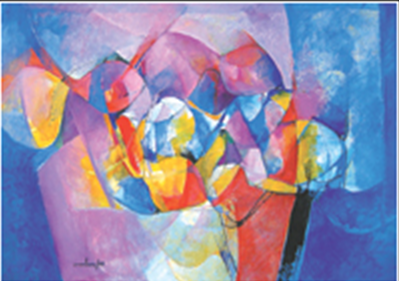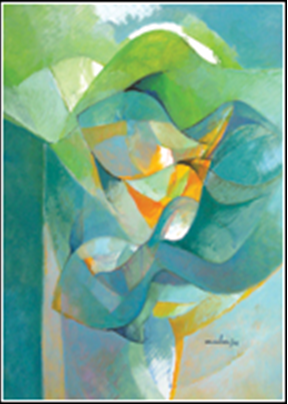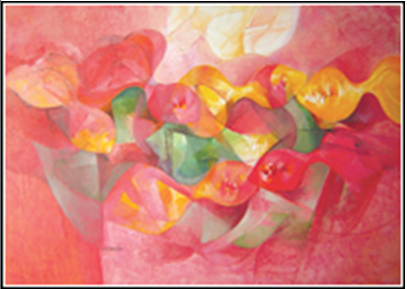Amber Aslam
This is a collection of articles archived for the excellence of their content. Readers will be able to edit existing articles and post new articles directly |
Amber Aslam
POP ART: Capturing rhythmic movements
Currently exhibiting a collection of her recent work at the Citi Art Gallery, Karachi one finds Amber Aslam’s handling of the medium immaculate; the result of years of continuous work and experimentation. Her vision transcends the obvious charm of the subject to seemingly ponder the mysteries of life’s changing patterns on a personal journey. There, symbolised by the gestural, geometric nuances, is a controllable world moving between light and shade. Enigmas represented by abstract colouration create moods suggested by changing hues.
The artist took her initial art training from the Karachi School of Art in the ’80s at a very significant era of the school’s presence in Karachi. Her work was approved by her teachers as having great potential. Aslam’s serious approach to art and the obsession with which she practiced and explored the media, led to the offer of a teaching post. She joined the faculty of KSA, and continued to examine her personal aesthetic problems with the media. At the end of the 1980s and early ’90s, she shared several exhibitions at the PACC Karachi, with her sister, Mehtab Amar Jamal. At that time both the girls were inclined to be romantic, creating languid beauties in shades of blues and greens in a wistful style that appeared influenced by the work of Hajra Rahi.
Aslam taught art for five years and felt frustrated that so little time was left for her own work. She was far from satisfied with her output and desperately needed time to experiment and evolve a personal aesthetic idiom for her art. She relinquished her teaching career and thereafter spent all her time involved in the process of painting. Days were spent working through the challenges of artistic expression, striving and exploring to create problems and find solutions on the surface of canvas.
At that time Jamil Naqsh was known as a source of encouragement to artists of promise, and taking her courage in hand, Aslam approached the maestro with her work. Naqsh was extremely kind. He viewed her work and the gauged the possibilities, and began by setting exercises for her to practice at home and to bring to him for discussion. Amber put her heart into the work and Naqsh approved of her consistent efforts. Naqsh became her mentor at a time when he was advising his daughter Mona who was deeply involved in art, and he tutored the two girls together. For a time the girls shared a studio and gradually the full-fledged artist emerged.
Like many young artists, Aslam sought a subject to express her views. Painting in her studio at home, she found her answer and her theme in an aquarium filled with graceful, constantly moving, exotic fish. With growing fascination, she noticed the light falling on the water creating a medley of patterns in harmony; movements that traced the cadenced flow of the bright creatures. She began to interpret the rhythmic movements of the aquatic world. From this simple point of departure, the artist discovered — and conveys in her work — an authoritative pictorial structure in which abstract colour and form generate an idiom of constantly changing, innovative imagery.
“ The theme of 'Goldfish in my aquarium' is an expression of my inspiration drawn from nature. I admire these creatures so much and when I apply the dexterous texture of oil paint, the medium in which I work, I try to capture the grace of the waltz in the aquatic dance…” — Amber Aslam
With Naqsh’s approval Aslam showed her work in critically acclaimed exhibitions held at the Momart Gallery, Karachi. Studying Naqsh’s oeuvre she concluded that the subject of a painting is a starting point and decided to continue expressing her viewpoint through the changing designs of her initial inspiration. After several solo exhibitions she became more involved with the practice of her art rather than the aspect of exhibitions. Though her work was in demand, she felt the need to create and solve her problems in greater depth while working without the interruption of demands.
She continued to paint without showing her work. The movements of water addressed her brushstrokes as she discovered myriad ever changing images, which appeared to reflect human existence in the whimsical light and colours of nature. Aslam’s water-world is a soothing visual fantasy, far from the urban greyness of actuality.— By Marjorie Husain
The exhibition will continue till April 22, 2008.
The artist conveys an authoritative pictorial structure in which abstract colour and form generate an idiom of constantly changing, innovative imagery




